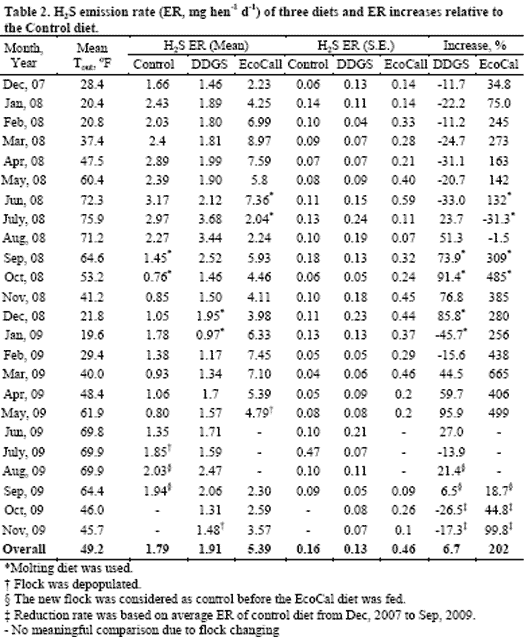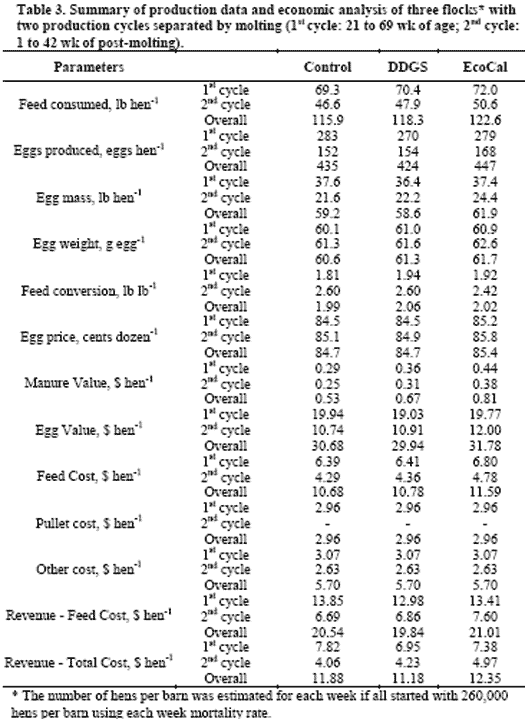



Mitigating Ammonia Emissions from High-Rise Hen Houses through Dietary Manipulation
Feeding diets containing EcoCal (at seven per cent) and distillers dried grains (DDGS; at 10 per cent) to laying hens resulted in a 39 per cent and 14 per cent overall reduction in ammonia emissions, respectively, according to a report in the Iowa State University Animal Industry Report 2011. Authors were H. Xin, H. Li, R. Burns, J. Kliebenstein, M. Ibarburu, S. Roberts and K. Bregendahl.Summary and Implications
Dietary manipulation can substantially lower ammonia (NH3) emissions from laying-hen houses or manure storage. Recent lab studies showed a ammonia emission reduction for experimental diets with EcoCalTM and corn dried distiller's grain with solubles (DDGS) as compared to the standard or control diet.
The study reported here was a field verification test about the effects of diets containing DDGS and EcoCal on air emissions, hen production performance and the economic returns for a commercial high-rise layer operation in Iowa. Comparative data were collected during December 2007 to December 2009.
Feeding the EcoCal diet at seven per cent inclusion rate and DDGS diet at 10 per cent inclusion rate to laying hens in the high-rise houses showed 39 per cent and 14 per cent overall reduction in ammonia emissions, respectively. There were few differences in egg production, egg weight or egg mass (output) for hens fed the EcoCal or DDGS diet as compared to hens fed the control diet. Compared with the control and DDGS hens, the EcoCal hens consumed more feed and had a lower mortality rate, and had a similar feed conversion. The EcoCal hens also tended to have a greater body weight. Egg production was slightly lower for hens fed the DDGS diet (424 eggs per hen or 58.5 lb per hen) than that of the Control (435 eggs per hen or 59.2lb per hen) and EcoCal (447 eggs per hen or 61.9lb per hen) hens. The lower egg production by the DDGS hens (during the first cycle) could have resulted from learning management of the new strain birds during the first cycle. The cash returns (revenue – total cost) of each hen were, respectively, $11.88, $11.18 and $12.35 for Control, DDGS and EcoCal regimens over the 91-week production period.
Introduction
Ammonia emissions from animal feeding operations (AFOs) have been estimated to represent the largest portion of the national ammonia emissions inventory in the United States, according to Professor Xin and co-authors. Excessive ammonia in animal housing adversely affect bird health and production performance. Understanding and mitigating air emissions from production facilities is an important issue for the US livestock and poultry industries. The US egg industry has been proactively looking for practical means to reduce ammonia generation and/or emissions from egg production facilities. One of the promising ammonia-lowering methods is dietary manipulation. Although lab-scale tests involving small number of birds had shown considerable reduction in ammonia emissions from manure of laying hens fed EcoCal or DDGS diet, field verification and demonstration of the promising dietary strategies are needed before consideration of their wider adoption by the egg industry.
The objective of this field project was to demonstrate, over an extended (two-year) period, the effects of feeding diets containing EcoCal or DDGS on emissions of ammonia and hydrogen sulphide (H2S), hen performance and production economics for commercial high-rise layer facilities.
Materials and Methods
This demonstration project was conducted with three commercial high-rise laying-hen houses located in central Iowa, each measuring 90 × 592 feet with a housing capacity of approximately 260,000 Hy-Line W-36 hens. Each house had 72, four-foot diameter exhaust fans along the sidewalls of the manure storage level, providing negative-pressure cross ventilation. Manure first fell onto the dropping boards below the cages and was then mechanically scraped into the storage four times a day (06:30, 09:00, 12:00 and 15:00h). Photoperiod of 16L: 8D was generally used except during the moulting period, which followed a different lighting programme. The three houses received three respective diets, namely, diet containing seven per cent (by weight) EcoCal (EcoCal), diet containing 10 per cent (by weight) DDGS, and control diet (Control). Weekly bird performance data, including feed and water consumption, egg production, mortality, bird age and body weight (BW), were collected and provided to the project team by the farm staff.
At the onset of the demonstration monitoring on 6 December 2007, hens for the dietary regimens had the following ages: 41 weeks for EcoCal, 30 weeks for Control, and 19 weeks for DDGS. Monitoring of all the houses started free of manure accumulation (i.e. after a complete removal of manure in the storage). Moulting started on 30 June 2008 in the EcoCal house, 14 September 2008 in the Control house, and 27 December 2008 in DDGS house (at age 72 to 75 weeks). A moulting diet without DDGS or EcoCal was used for the moulting period. The EcoCal house was depopulated during the period of 13 to 21 May 2009 and restocked by 9 June 2009; the new flock in this house was fed DDGS diet. The Control house was depopulated during the period of 16 to 24 July 2009 and restocked by 6 August 2009; the new flock was fed EcoCal diet. Finally, the DDGS house was depopulated during the period of 6 to 18 November 2009 and restocked by 17 December 2009 and the new flock was fed Control diet.
Feed consumption (g per hen per day) was measured as feed disappearance from the two bins per house. Egg mass was calculated by multiplying the percentage egg production by the egg weight. Feed conversion was calculated as mass of feed consumed divided by mass of eggs produced. Hen BW was determined monthly by weighing the same 100 hens in each house. Hen-level air temperature was recorded at the 3rd and 5th tiers and averaged by week. The manure storage of each house was cleaned in November 2007 prior to the study. After one year accumulation, the manure were removed and weighed separately for each individual house during the period of November 2008 to January 2009. Nine manure samples from each house were collected from nine selected representative locations and analysed for nutrient, pH and moisture content by a certified commercial lab.
A state-of-the-art mobile air emissions monitoring unit (MAEMU) housing the measurement and data acquisition systems was used to continuously collect data on ammonia, hydrogen sulphide and carbon dioxide (CO2) concentrations from the three laying hen houses. Air samples were drawn from three composite locations (east, middle, and west parts) in each house as well as from an outside location to provide ambient background data. Ventilation rate (VR) of each house was measured continuously. The gaseous emission rates (ER) were then calculated from the concentration and VR data.
The data were analysed for the period of 6 December 2007 to 5 December 2009. Analysis of variance of the data was performed using JMP (version 6.0, SAS Institute, Inc., Cary, NC). The dietary effect was considered significant at P-values <0.05.
Results and Discussion
Monthly means (±SE) ammonia and hydrogen sulphide ER for the DDGS, EcoCal and Control houses are summarised in Tables 1 and 2. The monthly mean ammonia ER was the lowest for the EcoCal diet (0.58±0.05g per day per hen), followed by the DDGS diet (0.82±0.04g per day per hen) and highest for the Control (0.96±0.05g per day per hen; P<0.01).


The efficacy of ammonia emission reduction by the DDGS or EcoCal diet was season dependent during the two-year monitoring period (P<0.01). The two-year overall ammonia emission reduction rate was 13.8 per cent and 39.2 per cent for DDGS and EcoCal diets, respectively.
The outcome of seasonal variations in the dietary efficacy could have stemmed from changes in the manure properties, especially moisture content, as the climatic conditions and VR varied considerably with the season. The monthly mean hydrogen sulphide ER for the EcoCal diet (5.39±0.46mg per day per hen) was significantly higher than that of the DDGS (1.91±0.13mg per day per hen) or Control (1.79±0.16mg per day per hen; P<0.001). However, no difference in hydrogen sulphide ER was observed between DDGS and Control (P=0.23). The mean hydrogen sulphide ER increased 6.7 per cent and 202 per cent for the DDGS and EcoCal diets, respectively. It should be noted that the magnitude of hydrogen sulphide ER was rather small in all cases. Hence, the 202 per cent increase caused by the EcoCal diet, as compared to the Control, should have little negative impact on the practicality of the dietary strategy.
The feed consumption, egg production and egg mass for the 1st cycle were estimated as the sum of the weekly feed consumption and egg production from weeks 20 to 69. The second cycle was defined as weeks 1 to 42 weeks after moulting. Hens in the EcoCal regimen consumed 6.7 and 4.3lb, respectively, more feed than hens in the Control and DDGS regimens for the periods of two production cycles of the first flock. The increased feed consumption might have led to the larger BW for the EcoCal hens. The mean BW over this period was 3.54, 3.52 and 3.69lb for the Control, DDGS and EcoCal hens, respectively. The greater BW for the EcoCal hens would in turn require higher energy for metabolic maintenance. Furthermore, air temperature was somewhat cooler in the EcoCal house (73.5°F) than in the Control (75.1°F) or DDGS (75.3°F) house, which could also contribute to the higher feed consumption. The overall feed conversions were 1.99, 2.06 and 2.02 for the Control, DDGS, and EcoCal regimens, respectively. Egg production was slightly lower for the DDGS hens (424 eggs per hen or 58.5 lb per hen) than for the Control (435 eggs per hen or 59.2lb per hen) or EcoCal (447 eggs per hen or 61.9lb per hen) hens during the two production cycles. Mean egg weights were 60.6, 61.3 and 61.7g, respectively, for the Control, DDGS, and EcoCal hens.
The prices of feed ingredients (corn, soybean meal, DDGS, meat and bone meal, fat and salt) were the 2007-2009 average prices for Minneapolis, Chicago and Kansas City as published in the Feedstuffs newspaper. Ecocal was priced at 8 US cents per cwt and micronutrients were priced at $1,000 per ton (personal communication between Ibarburu and industry nutritionist). The feed prices throughout the two-year period were estimated from the feed formulas provided by the producer and were $184.3, $182.2 and $189.0 per US ton (2000 lbs) for Control, DDGS and EcoCal diets, respectively. The manure values were $5.87, $7.35 and $8.95 per 1,000 hens per week for Control, DDGS and EcoCal diets, respectively. The egg price paid to producers was estimated using 2007–2009 Urner Barry prices minus a discount for washing, grading, packaging, etc. The pullet cost was assumed to be $2.96 per bird and all the pullets were paid in the first cycle and the starting cost of the birds in the second cycle was the cost of feeding them throughout the moulting period. The other costs, including labour, utilities, depreciation, insurance etc., were assumed to be 27.2 cents per month per hen housed. The returns (revenue – total cost) per hen were, respectively, $11.88, $11.18 and $12.35 for Control, DDGS and EcoCal dietary regimens over the 91-week period (49 weeks pre-moult and 42 weeks post-moult). Hence, EcoCal provides a viable means for reducing ammonia emissions and improving production economic efficiency.

Acknowledgments: Financial support (cash or in-kind) for the study was provided in part by the USDA NRCS Conservation Innovation Grant (CIG) Program, National Corn Growers Association, United Egg Association, American Egg Board, Rose Acre Farms, Iowa Egg Council, and Iowa State University College of Agriculture and Life Sciences. The authors wish to thank the Rose Acre Farm staff for their dedicated support and cooperation throughout the study.
March 2011








